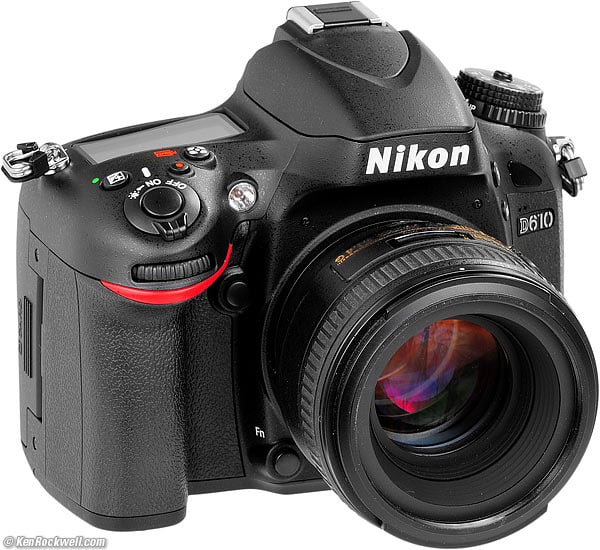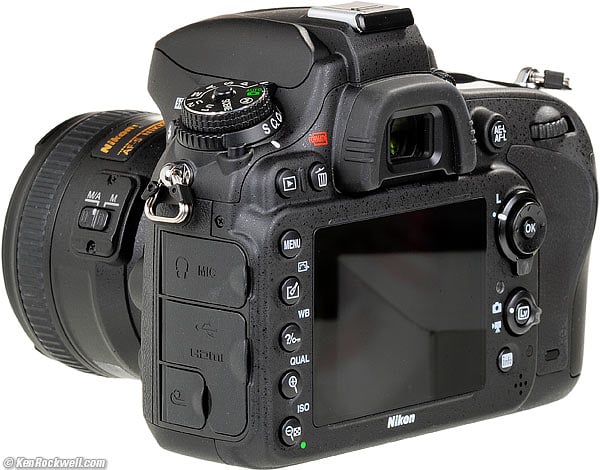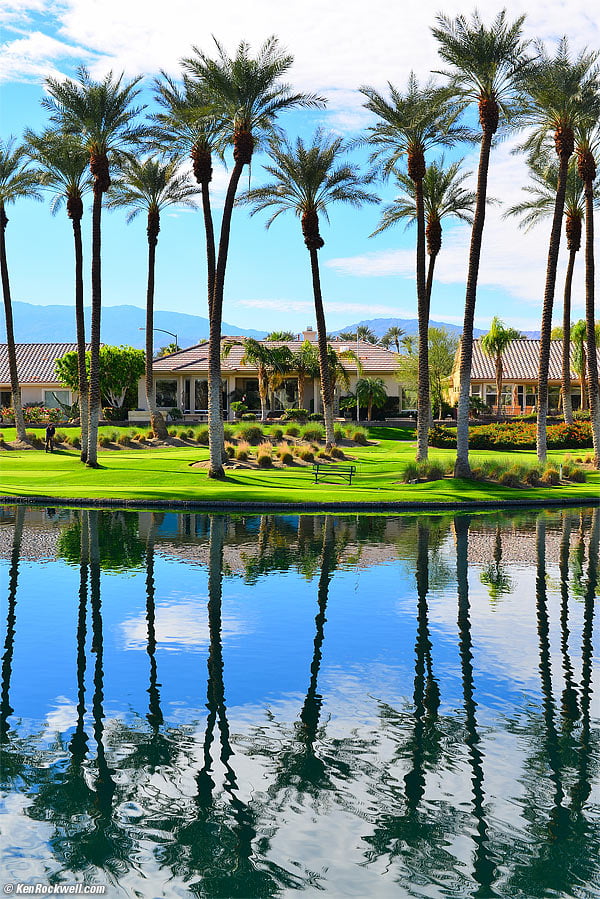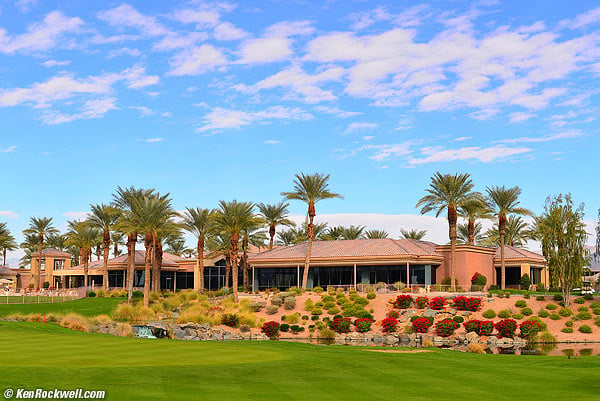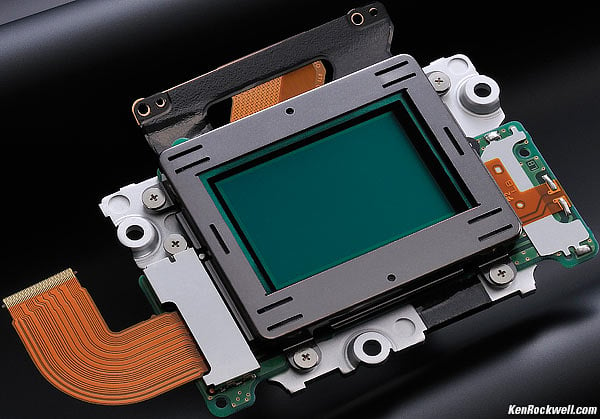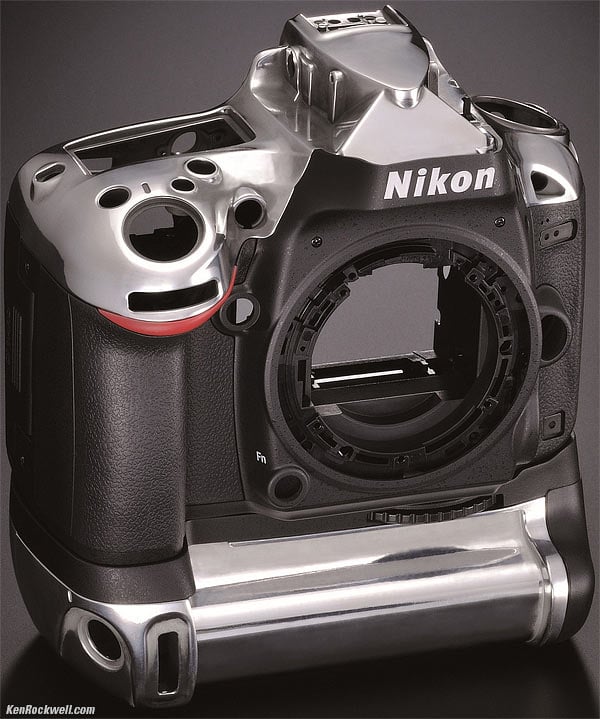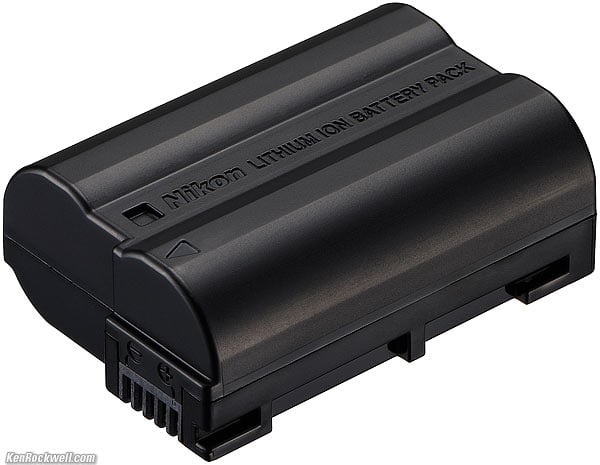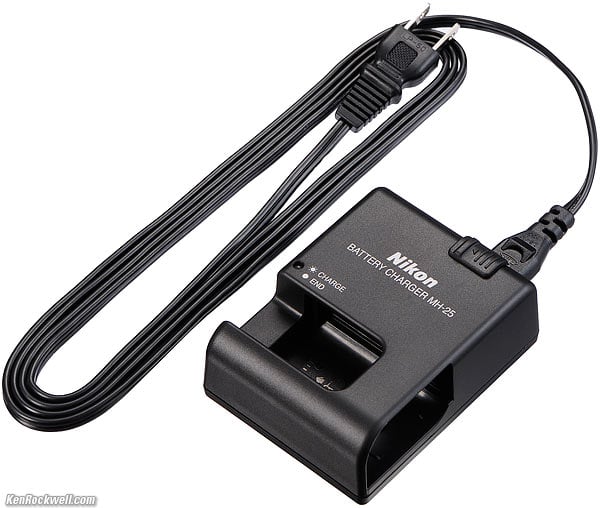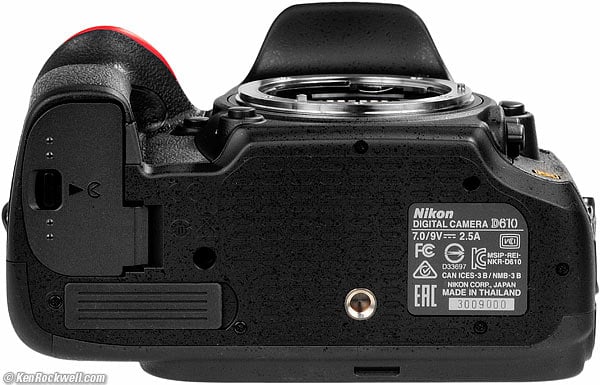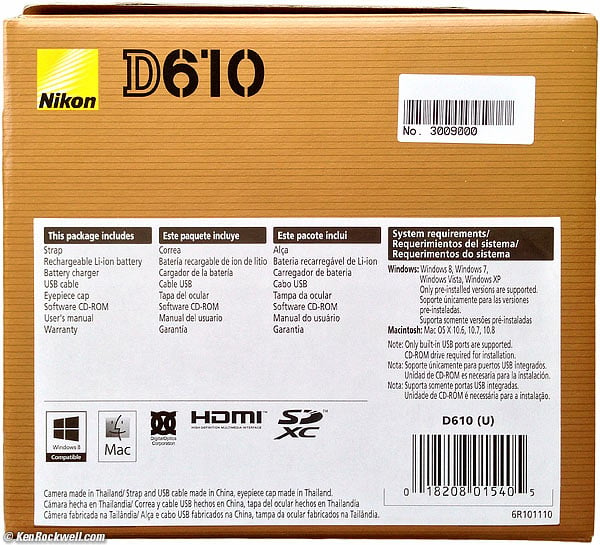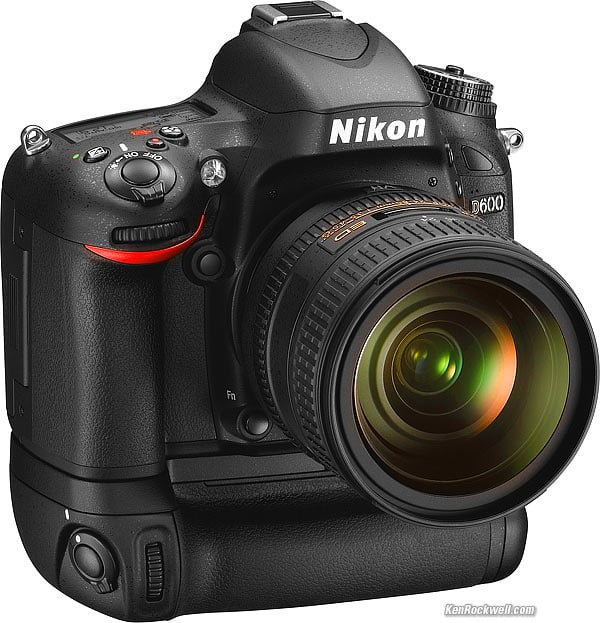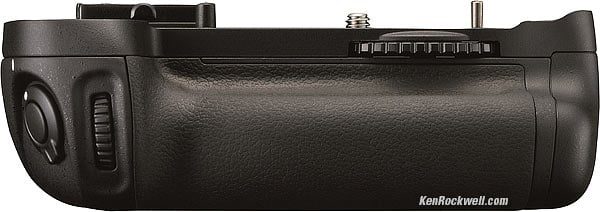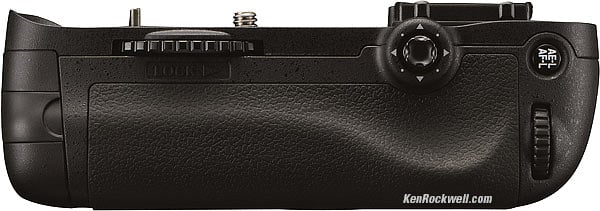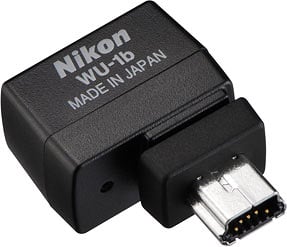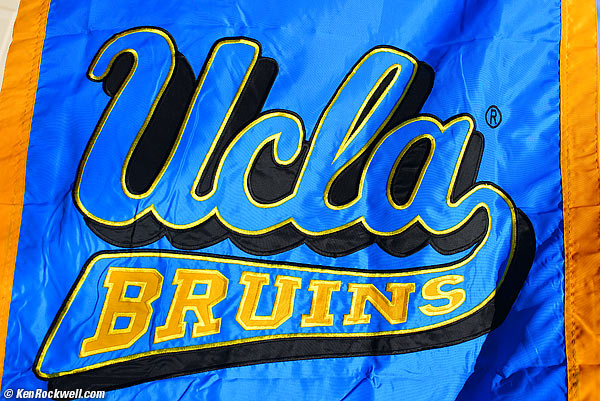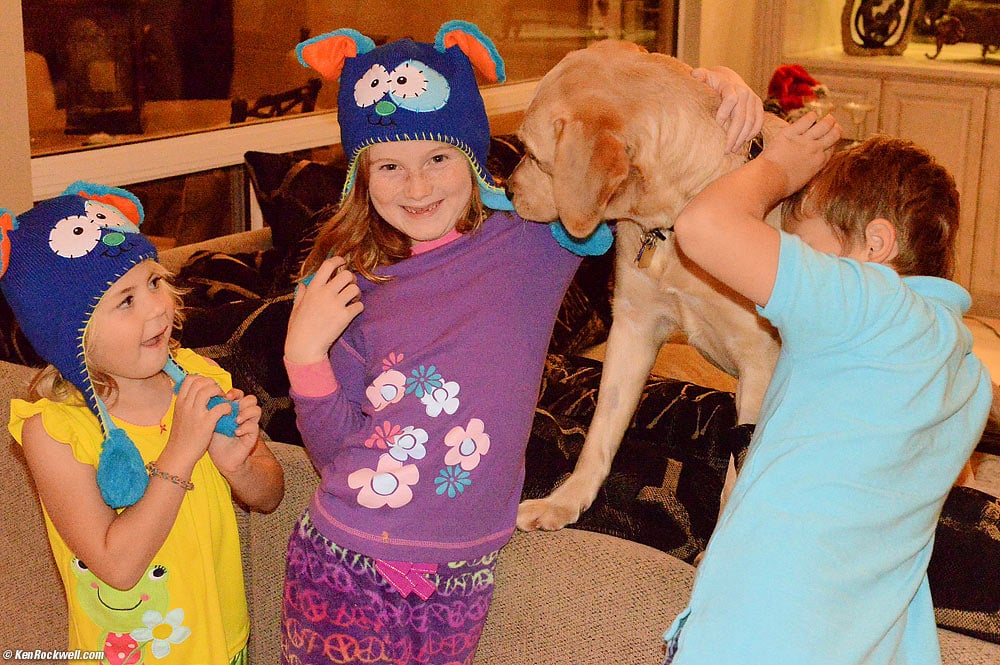Home Donate New Search Gallery Reviews How-To Books Links Workshops About Contact
Nikon D610
24 MP Full-Frame, 6 FPS, 2-SD cards
OBSOLETE. Get the D750, which is a better camera for less money.
Introduction Lenses Missing Specifications
Legal USA Version Accessories Performance
Compared Usage Recommendations More
Nikon D610 (30.0 oz./851 g with battery and card) and 50mm f/1.4 G. enlarge. This free website's biggest source of support is when you use these links, especially this link to the body at Adorama, the kit with 24-85mm VR at Adorama (all the versions and accessories at Adorama), or this link to them at Amazon or body-only at B&H, when you get anything, regardless of the country in which you live. If you don't use these links, I receive nothing for my efforts in sharing all this information for free. Thank you! Ken.
$1,497, body only with free goodies.
$1,897, kit with 24-85mm VR and free goodies.
$2,297, kit with 28-300mm VR, bag, SD card and more.
$2,457, kit with 24-85mm VR, 70-300mm VR, WU-1b, bag, SD card and more.
May 2016 More Nikon Reviews Nikon Lenses All Reviews
Nikon D750. Less weight and a better AF system in low-light.
Nikon D810, D800E, D600 and D3 Sharpness Comparison.
LEICA M240, LEICA M9, Fuji X100S and Nikon D600 Image Quality Comparison
Back, Nikon D610. enlarge.
Back, Nikon D610. Note new Qc advance mode. enlarge.
Top, Nikon D610. enlarge.
Sample Image Files (more throughout the review)
McDonald's. Nikon D610, Nikon 50mm f/1.4 G, f/10 at 1/400 at ISO 100, Auto ADR, VIVID Picture Control with 6 sharpening and +3 saturation. Camera-original © LARGE BASIC Optimum Quality JPG (4.5 MB).
Palms in Paradise, 28 November 2013. Nikon D610, Nikon 50mm f/1.4 G, f/8 at 1/250 at ISO 100, Auto ADR, VIVID Picture Control with 6 sharpening and +3 saturation. © LARGE BASIC Optimum Quality JPG (4.5 MB), losslessly rotated in iView Media Pro 3.1.3.
Noni's Wreaths, 29 November 2013. (Nikon D610, no flash, Nikon 50mm f/1.4 G, f/9 at 1/320 at ISO 100.) bigger or Camera-original © LARGE BASIC JPG file.
Introduction top
Introduction Lenses Missing Specifications Accessories
Performance Compared Usage Recommendations More
The Nikon D610 is Nikon's least expensive full-frame DSLR, and it's fantastic. The only reason to pay more for the D750 is because the D610's autofocus system doesn't work very well in light so dim that it's hard to read printed text, but so long as you're not trying to take pictures in pitch black darkness, the D610 is all anyone would ever need; it's a top-shelf camera at a bottom-barrel giveaway price. It sold for $2,000 when it came out in October 2013, and for $1,297 in 2016, it's a steal.
It's a minor update to the Nikon D600, which at the time was Nikon's best digital camera ever.
New in the D610 are a slightly faster shutter which runs to 6 FPS, as opposed to the 5.5 FPS of the D600, and a new 3 FPS Quiet Continuous (Qc) shutter mode. Otherwise, the D610 is the same body with the same size and weight, the same sensor, flash, battery, LCD and everything as last year's D600 — and the shutter still has the same 1/200 sync speed.
For feature counters, the D610 has 1080p HD video, built-in HDR, an electronic horizon and more — all the same as last year's D600.
Like most Nikon DSLRs, the D610 automatically corrects for any lateral color fringes in any lens, and for just about all Nikon lenses introduced in the past 20 years (any AF-D, AF-I, AF-S or G lens), also can automatically correct for lens distortion and corner light falloff. While it won't correct distortion with Nikon AI and AI-s manual focus lenses, it does provide full color Matrix metering, EXIF data and auto and manual exposure. Got a set of Nikon lenses from 30 years ago? You're already good to go with the D610; they'll look great.
The D5 runs faster and is the choice of full-time sports and action pros, but it has slightly less resolution than the D610. In practice, D4 images are almost as good, but the D4 is too heavy and lacks the critical U1 and U2 modes on the D610's top dial that I find so critical to my day-to-day use.
The D610's 24 MP is more than twice as much as anyone needs for anything. I'd be happy with only 10 MP in full-frame if it had the great U1 and U2 instant recall modes of the D610; utility is the difference between getting the picture and missing it; resolution today is so high it doesn't matter anymore, and some cameras like the D800 have such excessive marketing-driven resolution that the files bog everything down.
Whenever anyone packs this much large-format image quality into such a small package, I'm all over it! The D610's 24MP is enough for astounding mural-sized images without size limits if your lenses and technique are good enough, and the D610 is small and compact. 24 MP is astounding if you know what you're doing. If you do, mural-sized prints look spectacular.
Don't let the D610's small size and light weight fool you: the D610 is much faster than the D800: 6 FPS versus only 4 FPS! The D610 keeps cranking as fast as I ever need it to, and never, ever chokes on its 24 MP files, either.
Ryan at Mathis Brothers furniture clearance center, 29 November 2013. Nikon D610, no flash, Nikon 50mm f/1.4 G, f/1.4 at 1/125 at Auto ISO 160, Athentech Perfectly Clear. bigger.
Lens Compatibility top
Introduction Lenses Missing Specifications Accessories
Performance Compared Usage Recommendations More
AF Motor and Aperture Encoders, Nikon D610. enlarge.
With a built-in AF motor and an aperture feeler for manual-focus lenses, it works great with every Nikon auto- or manual-focus lens made since 1977!
The D610 works perfectly with every AF lens made since 1987, AF, AF-I, AF-D and AF-S.
It also works great with AI and AI-S manual-focus lenses, and if you update the really old ones to AI, all Nikon's SLR lenses from as far back as 1959 work just fine with color matrix metering and aperture-priority auto exposure and full EXIF data.
HINT: with manual-focus (non-AF) lenses, the D610 only works in the A and M top-dial settings (Aperture-priority and Manual exposure modes). In any other modes, like my favorite U1, U2 and P modes, it's not smart enough to revert to the A mode as are most other Nikon cameras.
This means you never have to buy today's new lenses unless you want to.
More at Nikon Lens Compatibility and Recommendations and Nikon FX Lens Recommendations.
Clubhouse, 28 November 2013. Nikon D610, Nikon 50mm f/1.4 G, f/8 at 1/250 at ISO 100, Auto ADR, VIVID Picture Control with 6 sharpening and +3 saturation. Camera-original © LARGE BASIC Optimum Quality JPG (4.5 MB).
What's Missing top
Introduction Lenses Missing Specifications Accessories
Performance Compared Usage Recommendations More
The only things I can find missing, which are so minor that I won't miss them, are:
AF sensors all crowded together in the center
Nikon claims a "new" AF sensor, but the D610's "new" CAM4800 AF array has the same size and sensor layout as the CAM4800DX array in the small-format (DX) D7000.
In English, this means that Nikon is only using a smaller DX AF sensor array in an FX camera, so all the sensors are crowded together in the center of the FX image.
Sure, they are reasonably placed if you're going to use the D610 in DX cropped mode, but that's silly, since you ought to use a D7000, which is simply a DX version of the D610 for half the price, if you're only shooting in DX.
In FX mode, which is the whole point of the D610, all the AF sensors are congested towards the center of the frame. Nikon could have used only three sensors for about the same level of usefulness.
No DSLR has full-frame AF yet, so it's not that big a deal.
I'm amused that the slow (4 FPS) D800 has a more flexible AF system (its sensors cover more of the frame), and the fast (6 FPS) D610 has the more limiting AF system for covering action, hee hee.
No 5:4 crop mode
I may be the only one on Earth who uses this feature in my other FX cameras, but especially for vertical shots, I love having my Function button set to let me crop off those unused ends as I shoot so I don't have to crop them later.
No PC (Prontor-Compur) flash terminal
So what? No one has used PC cords since wireless slaves were invented in the 1970s. People trip over PC cords and they always pull-out anyway, and if they don't pull out, they smash your camera onto the floor when someone does trip on them.
Again, no big deal. If you love 1940's flash technology, any hot-shoe to PC adapter, like Nikon's own AS-15 ($20), will give you your PC terminal back.
Personally, I use a cheap Nikon SB-30 from the 1990s in its IR trigger mode (or the D610's built-in flash at a lower-power manual setting) to trigger a Wein slave to run my studio strobes, never a cord.
No "Press center OK to zoom on playback"
Unlike Nikon's fancier DSLRs, the D610 has no option to program the center OK button to zoom-in to a preset magnification on playback.
I have to press ZOOM a few times to zoom in far enough.
As a consolidation, just flick the front dial when zoomed, and if there are faces in the picture, the D610 will flick among them instantly so you can check expressions and focus.
No AF-ON button
I never use this button.
If you do, CFN f4 lets you change the AE-L/AF-L button into an AF-ON button.
No AF-A mode
It has AF-C and AF-S, but not the AF-A mode which automatically selects the other two. The D810 also lacks this, while the D750 has it.
1/200 Flash Sync
No big deal, 1/200 is the same as 1/250 — only a third of a stop different than Nikon's hottest D3 and D4 pro cameras, and the same as the Canon 5D Mark III. (1/250 is available in an FP mode on the D610.)
No one makes DSLRs with 1/500 sync anymore. What happened is that the older DSLRs used hybrid electronic shutters that let them sync perfectly up to their top shutter speed (1/16,000 on the D1, D1H and D1X), and this was limited to 1/500 with dedicated strobes as not to lose any light. You could go straight to top speed with a non-dedicated flash in manual modes.
When resolutions grew above about 10 MP, the electronic shutters went away, so we're back to being limited by the mechanical focal plane shutter.
No big deal; 1/200 is the same as 1/250 as far as trying to get enough light on the subject is concerned. If I need 1/4,000 sync, I'll shoot my D70 or D40 — or my D1 at 1/16,000!
Three-frame bracketing maximum
I certainly don't care, but for people still doing olde-style HDR on their computers, bracket sequences are three frames maximum.
I've never used bracketing.
The D610 does have automatic in-camera HDR, so I certainly won't miss this one. I don't use HDR; I simply pop up the flash for much better results in harsh light.
Poor LCD Auto Brightness Control
The Auto Brightness Control doesn't work well enough to use; it's always too dark indoors.
If you want Auto Brightness control that works well, you need the Canon 5D Mark III or an iPhone.
No full-stop increments for exposure or ISO
This means I have to make a lot more clicks to get to my settings; I set in full stops, not fractions for ISO.
That's it!
That's all that's missing of any relevance compared to the D800 or even the D4, so as you can see, today DSLRs have become what 35mm SLRs were: they all take the same quality pictures, and differ only in their maximum frame rate for sports.
While insecure rich guys will always buy D4s and D800s just because they can even if they aren't going to use any of the features, today the D610 does everything I need it to.
Durability
With 35mm SLRs, we paid more for the "pro" cameras like the Nikon F5 because they were built as tough as an axle so we could pound on them for years. Once purchased, a pro 35mm SLR was the top camera for about the next ten years, and with something like an F5, you can pound the heck out of it for a decade or more and it will just keep shooting. With digital, most of us trash our DSLRs every few years long before they actually wear out. Durability isn't needed because technology renders our cameras obsolete long before they wear out.
The D610 has a one-year unlimited mileage warranty. If you wear it out, Nikon will probably fix it for free. If you can kill it after a year, Nikon rarely charges more than a few hundred dollars to repair anything you might break, and most of the time, you're not going to have a problem.
I shot the heck out of my far cheaper Nikon D40 for about three years as my main camera, and after over 50,000 shots, my 2006 Nikon D40 still works great today.
Canary Palm with Fusarium, 27 November 2013. Nikon D610, Nikon 50mm f/1.4 G, f/7.1 at 1/200 at ISO 100, Auto ADR, VIVID Picture Control with 6 sharpening and +3 saturation. Camera-original © LARGE BASIC Optimum Quality JPG (4.8 MB). (Upper right corner obviously not in focus.)
Specifications top
Introduction Lenses Missing Specifications Accessories
Performance Compared Usage Recommendations More
Sensor
Nikon D610 Sensor Assembly. enlarge.
24MP CMOS.
14-bit linear ADC, 16-bit processing.
Ultrasonic cleaner.
FX (24 x 35.9mm): 6,016 x 4,016 (L, 24MP), 4,512 x 3,008 (M, 13.5 MP) or 3,008 x 2,008 (S, 6 MP).
(if snapped during movie live view these are cropped to 16:9: 6,016 × 3,376 (L), 4,512 × 2,528 (M) or 3,008 × 1,688 (S).)
No 5:4 cropped mode.
DX (16 x 24mm): 3,936 x 2,624 (L, 10MP), 2,944 x 1,968 (M, 6MP) or 1,968 x 1,312 (S, 2.6MP).
(if snapped during movie live view these are cropped to 16:9: 3,936 × 2,224 (L), 2,944 × 1,664 (M) or 1,968 × 1,112 (S).)
Nikon D610 sensor. enlarge.
ISO
100 ~ 6,400 in the usual modes.
ISO 50 ~ 25,600 if you invoke the L-1 or H+ ISO settings, named that way simply to warn you that the picture may start to get a little ratty.
Live View
For both photos and for video.
Up to about 19x magnification for focus checking.
Video
Can't use the entire frame; crops-off 16:9 from the 3:2 sensor and uses that in both FX and in DX.
1,920 x 1,080 @ 29.97p, 25p or 23.976p: 24 MBPS or 12 MBPS.
1,280 x 720 @ 59.94p or 50p: 24 MBPS or 12 MBPS.
1,280 x 720 @ 29.97p or 25p: 12 MBPS or 8 MBPS.
Maximum clip length: 20 to 30 minutes.
Saves as MOV files containing H.264 MPEG-4 video and linear PCM audio.
Audio
Linear PCM, recorded only along with video.
Mono mic.
Input jack for Nikon ME-1 stereo mic ($130).
Auto or manual levels.
Stereo headphone jack.
Frame Rate and Buffer Size
6 FPS in FX.
6 FPS in DX.
Depending on card, to 100 continuous shots in JPG or 16 in raw. (Only 57 in JPG LARGE FINE.)
Finder
Glass pentaprism.
100% coverage FX.
(97% coverage DX.)
0.7x magnification with 50mm lens.
21mm eyepoint.
Switchable grid, in FX only.
Artificial Horizon (electronic level)
Roll and pitch displayed on rear LCD.
Roll-only displayed in finder, using the exposure bar graph.
Autofocus
39 points, mostly all crammed into the center of the FX image.
AF-assist incandescent light bulb, range 1.5-10' (0.5 ~ 3 m).
AF fine-tuning, if you have slight errors with certain lenses.
New CAM4800 sensor array, which has the same size and sensor locations as the DX-sized CAM4800DX AF sensor of the D7000.
Better than most previous sensors that only worked with lenses as slow as f/5.6, this new sensor can work with lens and teleconverter combinations as slow as f/8!
Like all DSLRs of 2012, it is not yet a full-frame AF system; it only sees a bunch of sensors all pretty much in the middle of the frame. The N55's three AF sensors pretty much cover the same area.
Notice that the AF areas don't cover as broad an area vertically or horizontally as do most other FX cameras:
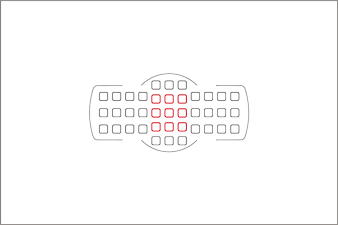
All AF points. These all work with lenses as slow as f/5.6. The red ones are cross-type, working with lenses and teleconverter combinations as slow as f/7.1.
In other words, all the sensors work with all lenses. Only if you're using a slow lens and a teleconverter (never a great idea), the D610's AF sensors may still work great, even better than older cameras.
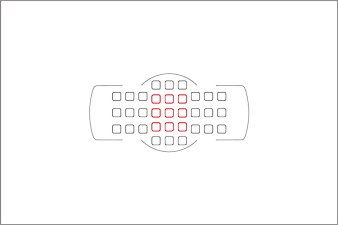
These AF points work with lenses as slow as f/7.1. The red ones are cross-type with lenses as slow as f/7.1.
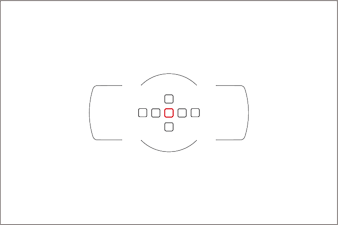
These AF points work with lenses as slow f/8. The red one is the only cross-type sensor that works with lenses as slow as f/8.
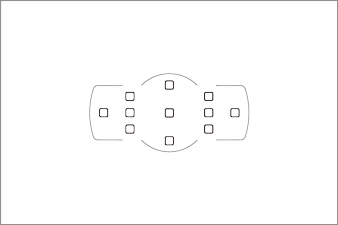
Simplified 11-AF point option for ease of selection.
Meter
2,016 pixel RGB 3-D matrix meter.
Center weighted.
Spot.
i-TTL for flash.
Shutter
1/4,000 ~ 30 seconds and Bulb.
Time exposures with ML-L3 Remote Control ($17).
Tested to 150,000 cycles.
Self-diagnostic shutter monitor.
Flash Sync: 1/200.
Quiet Mode: single or 3 FPS.
Remote Release: ML-L3 Remote Control ($17).
Built-in Flash
GN 39/12 (Feet/meters at ISO 100).
TTL, also manual settings in third stops down to 1/128 (MENU > CUSTOM > Bracketing/flash > e3 Flash Control).
Also works as COMMANDER for remote wireless flash.
Photo File Formats
No uncompressed NEF option, thank goodness.
JPG.
NEF.
NEF + JPG.
NEF is in 12- or 14-bit with lossy or lossless compression.
Rear LCD
3.2," 921,000 dots.
It seems like the same thing as the D800 and $6,000 D4.
Storage

Nikon D610 Dual SD Card Slots.
Two SD slots.
SDXC UHS-I.
Data & A/V Connections
USB.
Type C mini-pin HDMI connector.
3.5mm powered stereo mic input.
3.5mm headphone output.
Mechanics
Nikon D610 magnesium alloy top and bottom covers. enlarge.
Top and Bottom Covers: Magnesium alloy.
Partially weather-sealed.
EN-EL15, same as D7000 and D800.
Rated 900 shots.
If you use the MB-D14 grip, you can use a second EN-EL15 for a total of 1,800 shots, and the D610 will swap seamlessly between them. The grip can take six AA cells instead. You'll get 450 shots with 6-AA alkaline cells alone, or about 1,350 total with the EN-EL-15 in the camera and 6-AA in the grip.
Same dorky MH-25 charger, too.
Nikon EN-EL15 Li-Ion Battery.
Nikon MH-25 corded charger. enlarge.
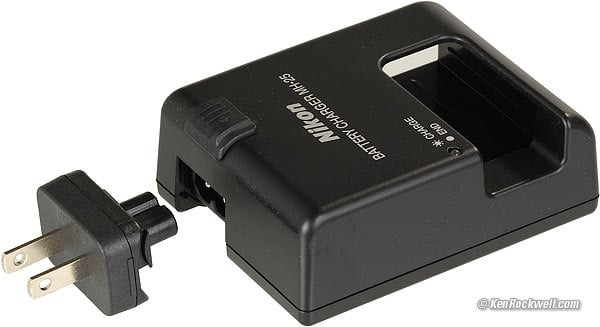
Nikon MH-25 Charger and Stub (USA).
MH-25 battery charger.
In the USA, the charger comes with both a cord and a more portable semi-folding stub.
Optional MB-D14 grip takes the EN-EL15 battery, or 6 AA cells.
Optional AC adapter EH-5a and EP-5 power connector.
Size
5.6 x 4.4 x 3.2 inches WHD.
141 x 113 x 82 millimeters WHD.
Weight
30.025 oz. (851.1g), actual measured with battery and one SD card.
Rated 30.0 oz. (850g) with battery and SD card.
Rated 26.8 oz. (760g) stripped naked without battery, card, strap, monitor cover or lens.
Quality
Bottom, Nikon D610. bigger.
Made in Thailand.
Included
D610.
EN-EL15 battery.
MH-25 charger.
DK-5 Eyepiece Cap.
DK-21 Rubber Eyecup.
UC-E15 USB Cable.
AN-DC8 Camera Strap.
BM-14 LCD Monitor Cover.
BF-1B Body Cap.
BS-1 Accessory Shoe Cover.
Nikon ViewNX 2 software CD-ROM.
Announced
Midnight between 07 and 08 October 2013.
Promised and Shipped
Late October 2013.
Price (USA)
May 2016
$1,497, body only with free goodies.
$1,897, kit with 24-85mm VR and free goodies.
$2,297, kit with 28-300mm VR, bag, SD card and more.
$2,457, kit with 24-85mm VR, 70-300mm VR, WU-1b, bag, SD card and more.
March 2016
$1,297, body only with free goodies.
$1,697, kit with 24-85mm VR and free goodies.
$2,097, kit with 28-300mm VR, bag, SD card and more.
$2,257, kit with 24-85mm VR, 70-300mm VR, WU-1b, bag, SD card and more.
Christmas 2014 ~ January 2016: $1,497.
April 2014
$1,896, body only with free goodies.
$2,396, kit with 24-85mm VR and free goodies.
$2,796, kit with 28-300mm VR, bag, SD card and more.
$2,846, kit with 24-85mm VR, 70-300mm VR, WU-1b, bag, SD card and more.
Christmas 2013
$1,999, body only.
$2,497, kit with 24-85mm VR.
$2,897, kit with 28-300mm VR, bag and SD card.
$2,947, kit with 24-85mm VR, 70-300mm VR, WU-1b, bag and SD card.
October 2013
$1,999, body only.
$2,599, kit with 24-85mm VR.
$3,049, kit with 28-300mm VR, bag and SD card.
$3,249, kit with 24-85mm VR, 70-300mm VR, WU-1b, bag and SD card.
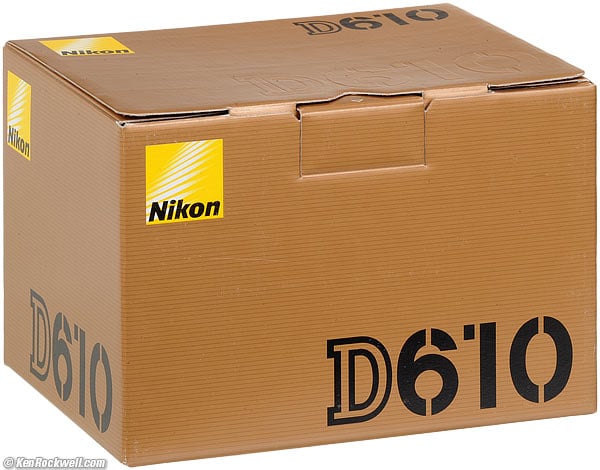
Box, Nikon D610.
Getting a Legal USA Version top
Introduction Lenses Missing Specifications
Legal USA Version Accessories Performance
Compared Usage Recommendations More
If you're in the USA, you need to get a legitimate USA version, otherwise you'll have no warranty, no way to get the newest firmware updates, and won't be able to get your D610 repaired even if you're willing to pay for it yourself. Buying online from approved sources means you'll get the right thing, but if you gamble and buy at retail or elsewhere online, you might get a model not authorized for sale in the USA, and you won't know until you try to get new firmware or need to get it fixed! Even if you offer to pay them, Nikon USA won't even look at non-USA versions, and they don't sell parts to independent repair places anymore either for this same reason.
How can you confirm you got a USA version? Easy: just look for the "(U)" after D610 above the UPC bar code:
Box end, USA version, Nikon D610. bigger.
Palms, 28 November 2013. Nikon D610, Nikon 50mm f/1.4 G, f/6.3 at 1/160 at ISO 100, Auto ADR, VIVID Picture Control with 6 sharpening and +3 saturation. © LARGE BASIC Optimum Quality JPG (4.5 MB), losslessly rotated in iView Media Pro 3.1.3.
Optional Accessories top
Introduction Lenses Missing Specifications
Legal USA Version Accessories Performance
Compared Usage Recommendations More
MB-D14 grip ($275).
It uses either the usual EN-EL15 Li-ion Battery, or six AAs (alkaline, Ni-MH or lithium).
Nikon D600 with 24-85 VR and MB-D14 Grip. enlarge.
If you keep one EN-EL15 in your D610 and a second in the grip, it will sequence between them seamlessly.
The MB-D14 grip has vertical controls, a shutter-release lock lever, an AE-L/AF-L button, a multi selector, and two command dials. It uses magnesium alloy for its exterior.
Nikon also sells replacement replacement MS-D14 AA holders ($45) and replacement MS-D14EN EN-EL15 holders ($45) separately for the MB-D14 grip.
EH-5B AC Adapter top of Nikon D610 Review top of specs page
There is an EH-5B AC Adapter ($80), which needs the EP-5B Power Connector ($50) to work.
GP-1A GPS top of Nikon D610 Review top of specs page
GP-1A GPS module ($279).
WU-1b Wireless Mobile Adapter D610 Review top
The new $50 WU-1b Wireless Mobile Adapter plugs into the D610's USB connector and then hangs out the side.
It allows two-way communication between the D610 and an iPhone or iPad or other Apple iDevice, or the Android. With an appropriate app (Nikon Wireless Mobile Adapter Utility), you can control the D610 remotely and see what it's doing via Live View on your iPod Touch or etc.
Once shot, the images also just fly into your iPad or whatever, from which you can send them out or do what you want with them.
ME-1 Stereo Mic
Nikon ME-1 stereo mic ($130).
ML-L3 Remote
ML-L3 Remote Control ($17).
Works with many other Nikons, too.
MC-DC2 Remote Cord
MC-DC2 Remote cord ($25).
Performance top
Introduction Lenses Missing Specifications
Legal USA Version Accessories Performance
Compared Usage Recommendations More
Go Bruins! Waving flag not all in focus, 30 November 2013, no flash, Nikon 50mm f/1.4 G, f/9 at 1/320 at ISO 100. Camera-original © LARGE BASIC JPG file.
Overall
Just like its almost identical-twin the Nikon D600, my D610 is my favorite Nikon full-frame DSLR because of its extremely high technical performance, superb ergonomics and small price, size and weight. I don't like my D800E or D4 because they require a lot more fiddling to optimize them from one shooting situation to the next, and with kids, I'm always needing to swap between optimum settings for family and for nature and landscapes.
Autofocus
Unlike my D7000 and most other DX cameras whose AF sensors cover most of their frames, the sea of AF sensors of the D610 only cover the central area of the finder.
AF is ultra-accurate shot at f/1.4. I shot all week with my Nikon 50mm f/1.4 G and Nikon 85mm f/1.4 G at f/1.4, and all my shots were dead-on with no need for AF fine tuning. Bravo!
The only limitation of the D610, just as with the D600, is that it can't see in the dark. If it gets too dark, the AF system needs its built-in white incandescent AF illuminator to be able to focus. If it's too dark and you're not in range of the AF illuminator, the D610's AF system simply locks up and doesn't focus.
A gotcha is that the AF illuminator annoys your subjects.
The AF menu system of the D610 provides for only two options for shutter firing: Focus or Release priority. Focus priority waits until the camera is in perfect focus to fire, while Release priority goes off any time you press the shutter — even if the picture is out of focus. The D610 has no in-between option as do fancier cameras to let us select a combination between Focus and Release Priority.
Auto ISO
AUTO ISO works great. You can program it with more flexibility than any other brand of camera. You can define the minimum and maximum ISOs, as well as the slowest shutter speed below which it starts increasing the ISO.
Better, you can easily program it to change the slowest shutter speed based on your lens' focal length, and again better than any other brand of camera you can shift this automatically selected slowest shutter speed up or down by up to two stops to let you optimize it all for action or still lifes with VR lenses, or anywhere in between.
Your preferred Auto ISO settings will save and recall with the U1 and U2 settings. I set the slowest speed to 1/125 for action in my U2 setting I use for family pictures, and I set it to Auto slowest shutter speed in my U1 setting for nature and landscapes.
Auto ISO with flash
In Auto ISO with flash in the dark, the D610 deliberately increases its ISO all the way to your selected maximum.
This is good because it allows the D610 to capture more of the ambient light in the background, which would otherwise look pitch black shot at ISO 100.
However, Nikon cameras aren't smart enough to use distance information to preset the lens aperture with flash, so Nikon cameras just guess and set a small enough aperture based on ISO so that the flash isn't likely to overexpose at close distances. For instance, Nikons choose f/2.8 at ISO 100, f/4 at ISO 400, f/5.6 at ISO 1600 and f/8 at ISO 6,400.
Here's where Nikon fails: using both Auto ISO and Program exposure with flash in the dark, the D610 works at maximum Auto ISO and stops down the lens according to that ISO, so you'll find yourself shooting at something foolish like f/8 at Auto ISO 6,400! The D610 isn't smart enough — yet – to drop the Auto ISO and use a larger aperture when you use Auto ISO and Program and flash at the same time in the dark.
Sure, I could stop what I'm doing and reset my camera to a lower top ISO or take other corrective action which would miss photos, but it's Nikon's responsibility to rectify their firmware so we don't have to work around it.
Otherwise, Nikon's Auto ISO is still the best in the business, although for use with flash, the Fuji X100S has the world's best fill-flash exposure programming. With Canon in Auto ISO, Canons simply select ISO 400 with flash, regardless of the ambient light.
Ergonomics
U1 and U2 (recalled on top mode dial and programmed in the Setup menu)
I love the U1 and U2 modes! These make it easy to swap the D610 between presets for completely different conditions. With my idiotic D800E or D4, which lack these, it can take a few minutes to swap between all my settings since their Menu Banks don't save and recall as much as do the U1 and U2 positions.
The U1 and U2 settings recall everything from program shift to Auto ISO settings to AF settings.
I preset my U1 to my personal settings for nature and landscape shots: LARGE BASIC JPG, VIVID Picture Control with +3 saturation, and Auto ISO set to Auto Slowest Shutter speed.
I preset my U2 for family shots: SMALL BASIC JPG, Standard Picture Control, and Auto ISO set to 1/125 slowest shutter speed.
One minor complaint is that when you save your current camera state to one of the U1 or U2 settings,the D610 always tries to save it to U1 — even if you're already in U2 and were simply trying resave it with a slight change. You may write over your U1 setting if you're not careful.
I share my settings file for all this at Usage.
ISO and Exposure Settings
I love AUTO ISO, however the D610 lacks the ability to set ISOs and aperture and shutter speeds directly in full stops. It only has selections for third or half stops, but not full stops, so I have to go through a lot more clicks to get the manual ISOs I need.
Playback
My biggest whine about the D610 is that I can't program its OK button to zoom-in with one click. I have to press the (+) button several times, every time, to see if I'm in focus.
Like most Nikons, the Play button needs a second (left) hand. You can't hit play when you're shooting one-handed, although if you make a shot and have IMAGE REVIEW set to ON, that can get you into the system.
Power Switch
The power switch lacks a sorely needed lock, so it's easy for it to get knocked to ON in your bag, or get knocked to OFF as you're shooting and miss your shot.
Mode Dial
Since the mode dial rotates 360°, we can't set it by feel as we can on Canon cameras which stop at one end.
Exposure
The meter tends towards overexposure if there are large areas of black. It's not uncommon for me to shoot at -0.7 exposure compensation (see Usage for how to do it).
The Program mode shifts its selections with focal length. With an 85mm lens for instance, it shoots at 1/500 at f/5.6.
Flash
Flash Exposure
I find that flash usually overexposes, be it the built-in or an external flash.
I set -0.7 stops flash exposure compensation (see Usage for how to do it) and then it works fine.
Built-in Flash
The built in flash works great both indoors and out; few people will have any need for an external flash.
I find that the built-in flash is a bit cooler (bluer) than I prefer.
As typical for built-in flashes, if you're using it for outdoor fill flash, it may take a few seconds to recycle and get ready for the next shot. The bad news is that the D610 locks-up and won't shoot again until the flash recycles! Most cameras take the next shot without flash if the flash is still recycling from the last shot, while the D610 simply hangs up. Even worse if shooting in a Continuous mode, you have to release the shutter and get back on it to fire the next shot; you can't simply leave the shutter down and expect the D610 to fire when the flash becomes ready.
Frame Rates
At 6 frames per second, the D610 really flies compared to most consumer cameras. I remember when my professional Nikon D1H was the hottest pro digital camera on earth in 2002, with only 5 FPS.
See Usage for how to shot sports with the D610.
HDR
High Dynamic Range (HDR) is a feature that attempts to retain detail in scenes with huge differences from dark to light. It works great.
I can turn on HDR and snap hand-held. The D610 auto-aligns the images and creates and saves a final image in a few moments.
You'll see it pause and show "JOB HDR" while it processes the images; you can't shoot quickly with this feature.
Thankfully I set my D610 to NATURAL and the results indeed look natural, not forced. It often doesn't do much because HDR is only rarely needed. If you have a scene that does need it, like indoors with a window looking outside or in a slot canyon, HDR works very well. It subtly retains detail in the lightest and/or darkest parts of the picture.
High ISOs
The D610 stops at ISO 25,600, at which setting it doesn't look very good. ISO 25,600 is enough for anything, but better cameras like my Canon 5D Mark III go to even crazier settings like ISO 102,400.
The D610's high ISOs are more than enough, but nothing extraordinary. At ISO 6,400 there is some noise, just like ISO 100 film:
ISO 6,400: Ryan smiles. (Nikon D610, no flash, Nikon 50mm f/1.4 G, f/1.4 at 1/125 at ISO 6,400, Athentech Perfectly Clear.) Camera-original © SMALL BASIC JPG file.
At ISO 25,600 it's still quite usable, however the finer structures of the image are starting to disappear as the noise reduction starts eating away at everything.
ISO 25,600: Even Bella loves the Flipeez hats! Nikon D610 with built-in flash, Nikon 50mm f/1.4 G, -2/3 stop exposure compensation, program auto and Auto ISO chose f/8 at 1/125 at ISO 25,600. bigger or Camera-original © SMALL BASIC JPG (1.3 MB).
LCD (rear)
The rear LCD isn't very accurate. I find, just as with every other current full-frame Nikon, that it tends to emphasise yellows and greens. My Canon cameras are much better.
The Auto Brightness control works poorly. I expected Nikon to fix this from the D600, but the D610's LCD is still too dark indoors if set to AUTO, so I have to leave it on Manual brightness control.
Oil Spots
None seen.
I never saw any on my D600 either, and my one friend who did send his to Nikon under warranty and his spots went away and never came back.
I suspect the problem with the D600 was more the power of suggestion. People thought there was a problem and went looking for it, and guess what: if you shoot any DSLR at the sky at small apertures, you'll always see some spots. Of course it's stupid to shoot the sky at f/16 because you don't need depth of field, but you will lower lens resolution from diffraction and see any dirt on the sensor, even if it's completely insignificant for real photography.
In any case, here's the sky at f/16 with the contrast jacked all the way up on my computer to exaggerate any slight dust or oil, and I still can't see anything dirty on my D610:
Clouds at f/16 with the contrast jacked all the way up with Athentech Perfectly Clear in Photoshop CS6. Full-resolution.
Power and Batteries
I get about 1,300 shots per charge, many with the built-in flash, which is excellent.
Sadly the battery charger is retarded. It uses an idiotic, clumsy and easy to break removable swiveling plug instead of an integral folding plug. If you prefer to use it with a common power cord, the goofy stubby plug comes off.
Quiet Modes
The D610 is already quiet, especially compared to big, noisy professional cameras like the Nikon D4.
The Quiet modes aren't much quieter than the regular modes. This is OK, since they aren't much slower, either.
The D600 is quieter than Nikon's or Canon's pro cameras; it's smaller and more refined while the pro cameras are much faster and louder.
Compared top
Introduction Lenses Missing Specifications
Legal USA Version Accessories Performance
Compared Usage Recommendations More
NEW: LEICA M240, LEICA M9, Fuji X100S and Nikon D600 Image Quality Comparison 11 March 2014
The D610 is a D600 with a slightly faster shutter. The D610 really exists only to dispel fears over an overblown D600 oil sputtering problem, which I never saw.
| Announced | 10/2013 |
9/2012 |
2/2012 |
9/2010 |
7/2008 |
| Format | |||||
| Resolution | 24 MP |
24 MP |
36 MP |
16 MP |
12 MP |
| Frame Rate | 6 FPS |
5.5 FPS |
4 FPS |
6 FPS |
5 FPS |
| U1 & U2 Modes? | YES |
YES |
no |
YES |
no |
| AF settings easy save and recall? | YES |
YES |
no |
YES |
no |
| External AF Controls | Abbreviated |
Abbreviated |
Abbreviated |
Abbreviated |
Full |
| LCD | 3.2" 921k dots |
3.2" 921k dots |
3.2" 921k dots |
3" 921k dots |
3" 920k dots |
| ISO normal | 100 ~ 6,400 |
100 ~ 6,400 |
100 ~ 6,400 |
100 ~ 6,400 |
200 ~ 6,400 |
| ISO with L- and H+ values | 50 ~ 25,600 |
50 ~ 25,600 |
50 ~ 25,600 |
100 ~ 25,600 |
100 ~ 25,600 |
| Battery | EN-EL15 |
EN-EL15 |
EN-EL15 |
EN-EL15 |
EN-EL3e |
| Sync Speed | 1/200 |
1/200 |
1/250 |
1/250 |
1/250 |
| AF Points | 39 |
39 |
51 |
39 |
51 |
| Portion of frame served by AF points | very small |
very small |
small |
small |
small |
| Body toughness | consumer |
consumer |
semi-pro |
consumer |
semi-pro |
| Weight w/ card and battery | 30.0 oz. 850 g. |
30.0 oz. 850 g. |
35.1 oz. 994 g. |
27.3 oz. 774g |
38.3 oz. 1,085 g. |
| Storage | SD + SD |
SD + SD |
CF + SD |
SD + SD |
CF only |
| Body price, 9/2012 | n/a |
||||
| Body price, 10/2013 |
For far more details tabulated, see my 2012 DSLR comparison.
Usage top
Introduction Lenses Missing Specifications
Legal USA Version Accessories Performance
Compared Usage Recommendations More
Initial Setup
If you want to set your D610 exactly as I set mine, download this file to your computer, (try right-clicking and hit SAVE AS if it doesn't just save itself as it does on my Mac), copy it to a memory card, stick the card in your D610, and go to MENU > SETUP > Save/load settings > Load settings > OK. Do this and the zillion little things I set but don't explain here will be set for you.
This will program your U1 for nature and landscapes, and your U2 for people and family pictures. It also will program your autofocus, color settings, files sizes, your My Menu, and everything exactly as I shot my D610.
Note 1). Of course these settings replace any you may have set already. If you want to return to your own settings after trying mine, remember first to set MENU > SETUP > Save/load settings > Save settings > OK and then copy your NCSETUPC.BIN file from your card to someplace you can find it again — or just put that card aside and don't SAVE over it.
Note 2). Clicking this file does nothing here in your browser. You have to save it to an SD card and read it in your D610 for the file to do anything.
Note 3). Since I set my IMAGE COMMENT to © KenRockwell.com, your images EXIF data also will be marked this way. This should give you the incentive to go to MENU > SETUP > Image comment > Input comment and change it to your own name and contact information. Hint: you have to click DONE when done, or it will ignore your changes.
If you don't use my settings, do be sure to set the Shoot without card menu option to NO WAY! If you don't set this, the D610 is defective in design and cheerfully will shoot all day with no card in the camera. The only reason for this default setting is so that typically incompetent salespeople typical in retail stores can show the camera without having to set anything, but this error by Nikon means that you could think you're shooting an entire wedding or vacation — on no card!
Set Modeling Flash to OFF (MENU > Custom > e5 Modeling flash > OFF). Otherwise the D610 fires the flash at full power any time one is active and you press the depth of field preview button.
To use the dials to zip through the menu system as well as swap different images and data fields in playback, set MENU > Custom > f5 Customise command dials > Menus and Playback to ON.
My Menu menu
I fill my My Menu menu with my favorite items, including Auto ISO settings. If you use my settings file above, you'll already have the same ones I use.
The catch is that you cant assign Auto ISO settings to the My Menu; you have to select the "ISO sensitivity settings" option instead, inside of which you can get to the Auto ISO settings.
Also in my settings file, I prefer to set my Fn button to Select Top item in My Menu. To get to other items in My Menu, just click left to see them.
Exposure Compensation
To set exposure compensation, which makes the next pictures you take darker or lighter, hold the +/- button (near the shutter button) as you spin the rear dial. You'll see a number on the top LCD or in the finder as you set this. + means brighter, and - is darker, Easy.
I usually leave exposure compensation at 0.
Flash Exposure Compensation
This is how we set the brightness of the flash. They flash is usually too bright, so I set mine to -0.7 stops and leave it there.
To set this, press and hold the +/- flash-bolt button and spin the front dial until you see -0.7. Don't turn the rear dial as you do this unless you want to change the flash sync mode. The +/- flash-bolt button is located just below the flash halfway between the mode dial on the top left and the NIKON logo on the front.
Built-in Flash
To turn it on,pop it up by pressing the +/- flash-bolt button located just below the flash.
To turn it off, push the flash back down.
To use the built-in flash as a remote commander to control other Nikon wireless flashes, set MENU > CUSTOM > Bracketing/flash > e3 Flash Control > Commander mode.
To force the built-in flash to fire at the same manual power level for every shot, for instance as a trigger for studio strobes, set MENU > CUSTOM > Bracketing/flash > e3 Flash Control > Manual > and choose the power level.
Be careful not to let your Auto ISO choose too high an ISO when shooting with flash.
Sports and Action
For shooting sports and action, see How to Set the D7000's AF system, which sets the same way as the D610's AF system. Also see How to Shoot Sequences with Flash and How to Shoot Sports.
Recommendations top
Introduction Lenses Missing Specifications
Legal USA Version Accessories Performance
Compared Usage Recommendations More
As of March 2020, the D610 is obsolete. Get the D750, which is a better camera for less money.
Overall
The D610 has the optimum resolution for FX. The D800 has too many pixels which clogs my hard drives, slows my workflow, and the D800 can't shoot as fast for the same reason.
The D610 and D600 have the best ergonomics of any FX Nikon, ever, because of its U1 and U2 settings which all ow instant recall of all camera settings. Even the D4 lacks this — and the D4 has less resolution.
The only gotcha with the D610 and D600 is that their AF systems go blind in very low light, demanding the use of their AF illuminators. If it gets very dark without the AF illuminator ON, their AF systems don't focus.
Lenses
The kitted optional 24-85mm VR is an excellent lens, and you have your choice of any of Nikon's hundreds of other lenses made today and for more than 50 years if you prefer. Honestly, one of my all-time favorites is my 50mm f/1.8 AF-D that sells for $125! See Nikon Lenses and Nikon FX Lens Recommendations and follow their links for a ton of information and recommendations.
If you want a do-everything lens that's the direct FX replacement to the 18-200mm in DX, get the 28-300mm VR. It could be the only FX lens you ever need, but it is bigger than I'd want to carry every day.
Want to know the only lens I use with my D610 for family and travel photos? It's my 50mm f/1.4 G. The 50/1.4G is small, light, inexpensive and super fast for low light. All the sample photos in this review were shot with it.
Do not use DX lenses on the D610. Yes, they will take pictures, but your viewfinder will show a small rectangle, which is the only part of the picture that actually will be recorded. With DX lenses you throw away most of the performance of the D610. Use only FX lenses on the D610, or use a DX camera like the D7100 with DX lenses. With DX lenses, the D7100 will give better results than the D610 will with DX lenses.
Flash
Try the built-in before you go buying anything else. The built-in flash is great for everything for which you'd use on-camera flash.
Only if it lacks range or recycling speed, or if I'm doing a lot of hard, rapid shooting, will I use my SB-400 flash. With digital's high ISOs, there's rarely any need for the big flashes like the SB-700 or SB-910.
Thank you!
If you've found the time, effort and expense I incur for you in researching and sharing all this for free, this free website's biggest source of support is when you use these links, especially this link to the body at Adorama, the kit with 24-85mm VR at Adorama (all the versions and accessories at Adorama), or this link to all versions at Amazon or body-only at B&H, when you get anything, regardless of the country in which you live.
Thanks!
Ken
More Information top
Introduction Lenses Missing Specifications
Legal USA Version Accessories Performance
Compared Usage Recommendations More
Help me help you top
I support my growing family through this website, as crazy as it might seem.
The biggest help is when you use any of these links when you get anything, regardless of the country in which you live. It costs you nothing, and is this site's, and thus my family's, biggest source of support. These places have the best prices and service, which is why I've used them since before this website existed. I recommend them all personally.
If you find this page as helpful as a book you might have had to buy or a workshop you may have had to take, feel free to help me continue helping everyone.
If you've gotten your gear through one of my links or helped otherwise, you're family. It's great people like you who allow me to keep adding to this site full-time. Thanks!
If you haven't helped yet, please do, and consider helping me with a gift of $5.00.
As this page is copyrighted and formally registered, it is unlawful to make copies, especially in the form of printouts for personal use. If you wish to make a printout for personal use, you are granted one-time permission only if you PayPal me $5.00 per printout or part thereof. Thank you!
Thanks for reading!
Mr. & Mrs. Ken Rockwell, Ryan and Katie.
Home Donate New Search Gallery Reviews How-To Books Links Workshops About Contact

